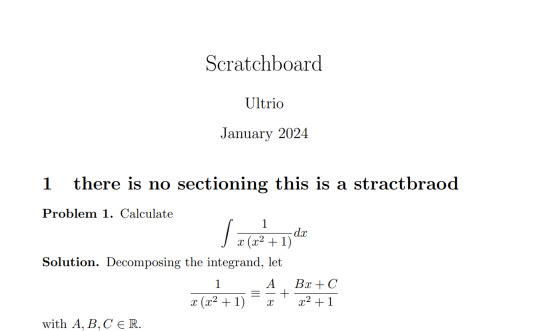#partial fraction decomposition
Explore tagged Tumblr posts
Text
First class today,
discussion for Math 32B. Considering we haven't even had our first lecture yet, that discussion was pretty damn productive. The TA reviewed a bunch of integration techniques from previous classes, making me realize how much I really missed doing math.
Nerdy, iknowright?
I'm looking forward to this coming quarter. :3
37 notes
·
View notes
Photo

Yes, you have the general idea of it. Let's go through this again, step by step.

Separate it into:

Distribute A and B to its corresponding factors:

Which can be rearranged as:

So, you're left with
and
To solve for A, multiply the first equation by 3, so you're left with the same amount of B's in both equations. Then subtract the first equation by the second, which should look like this (forgive my notation, I'm no good with writing equations on a computer):
Then, to find B, simply plug in the result you found for A into one of the equations you came up with above and solve for B.
There you have it! And from then simply plug in your values for A and B and integrate as you normally would. Hope this helped!
- Jay
9 notes
·
View notes
Text
Integration practice - Fraction Decomposition




Absolute beaut if I do say so meself
(I don't know what accent I'm doing)
5 notes
·
View notes
Link
2 notes
·
View notes
Text

1 note
·
View note
Photo

How to do Partial Fraction Decomposition?
Partial Fraction Decomposition is an algebraic technique used to convert a complex rational function into a sum of two or more simplex fractions.
A rational function is a function where two polynomials are in division. In some cases where the degree of denominator is greater than or equal to numerator, direct integration is quite difficult. To deal with such problems, we adopt a technique called Partial Fraction Decomposition.
The following infographic will help you in understanding how to integrate complex rational function having linear repeated factors
#partial fraction decomposition#partial fraction expansion#partial fraction rules#partial fractions examples#integration by partial fractions
0 notes
Note
i'm here to ask for help! if you have any idea how to explain solving integrals by partial fractions i will love you forever.
Okay, so partial fraction decomposition:
The idea behind this technique is that we know how to integrate things in the form
pretty easily. (Namely, you get ) So we want to use this fact to help evaluate integrals of the form
i.e. integrals with a polynomial in the denominator.
To use partial fraction decomposition, your polynomial must be factorable into linear factors. Let's do an example. Suppose you want to evaluate
What we're going to do is break up
as the sum of two fractions. (In general, if your polynomial is a degree n polynomial, you will have n terms in your sum.)
Notice if we take some multiple of and add it to some multiple of the sum is going to have (x+3)(2x-5) in the denominator! This is the key idea that makes partial fraction decomposition work.
So we set
This holds true for all x, so in particular, if we set x = -3, we get
or 1 = -11A. This gives you A = -1/11. Similarly, letting x = 5/2, we get B = 2/11.
So now we know
What does this mean?
We know integrals are additive, i.e. So if we want to evaluate
all you have to do is evaluate
But we can do that! (See way up top.)
There's something slightly subtler that happens when your polynomial has repeated factors, though. Consider taking the partial fraction decomposition of You can't just take because you won't get (x-1)^2 in the denominator. Instead, what you're going to have to do is take
In general, if your polynomial has the factor (x-a)^n, you want to decompose it into
and all these terms should be integrable because you have functions in the form (deg n-1 polynomial)/(deg n polynomial).
Hope that helped!
- H2
8 notes
·
View notes
Note
How would I integrate (7x^2)/[(x-3)(x+2)^2] using partial fractions?
Well first of all we factor out the constant:
By using partial fractions we find:
After that we're going to integrate the sum term by term and factor out constant:
We know that ∫(1/u)du = ln(u) and ∫(1/v^2)dv = -1/v so:
The final answer is:
I hope this helps.
-Nidal
3 notes
·
View notes